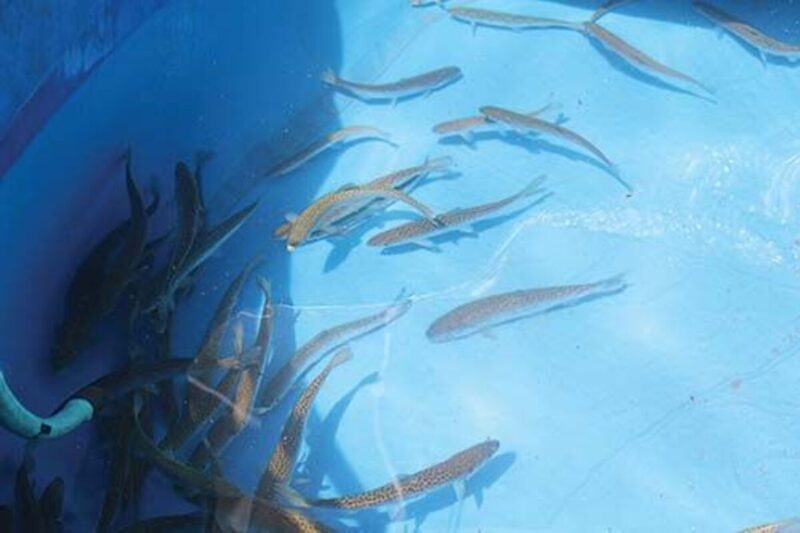Sean C. Morgan
For a young salmon or steelhead, going over a 450-foot dam can be a big problem.
Green Peter Dam may hold the solution for spring Chinook and winter steelhead trying to do that at Cougar and Detroit dams.
The U.S. Army Corps of Engineers has conducted experiments, most recently at the end of June, to find out just what juvenile fish may face sliding through a pipe down the face of a dam, what the likelihood of injury is and what kind of injuries the young fish might sustain.
“We are exploring ways to move the fish from a trap above the dam to the river below it with little to no human or mechanical handling,” said Corps Spokesman Scott Clemans. “We’ve pretty much figured out how to get juvenile salmon and steelhead past our relatively short, 60 to 110 feet, Columbia River dams – 95 percent or more survive the trip past each one. Now we’re being asked to do the same thing at several of our very tall, 450 feet-plus, Willamette Basin dams, and that’s a whole different ballgame.
“We are using Green Peter Dam as a laboratory to study a possible downstream solution for fish passage at Cougar and Detroit.”
Green Peter Dam has the infrastructure in place already, although neither Green Peter nor the Middle Santiam River are included in the National Marine Fisheries Service’s Willamette Biological Opinion, which sets performance goals for per dam survival of spring migrants and summer migrating fish.
Detroit and Cougar are, but they don’t have the infrastructure in place to test the possible solution for juvenile downstream passage.
In what’s called a “high head bypass fish study,” researchers put live hatchery steelhead and salmon down an unused chute at Green Peter along with “sensor fish,” which record data about the forces, pressures and velocities fish may experience.
The system has four intakes at different elevations in the reservoir to an old fish passage system that bypasses the dam’s turbines, spillways and regulating outlets, Clemans said. It’s part of the original construction of Green Peter, completed in 1968. Detroit was finished in 1953, and Cougar was finished in 1963.
The system remained in use until 1987, said Fenton Khan, a fish biologist with the Corps. Adult fish were lifted up the face of the dam and then lowered into the lake. Juveniles would use the four intakes and the pipe to go downstream.
Adult fish were deterred from traveling upstream by cold water drawn from the bottom of the reservoir through the powerhouse, Khan said, and the Corps stopped passing fish over Green Peter in any direction.
Adult fish are collected and trucked upstream from fish passage facilities below Detroit and Cougar dams, similar to the new one below Foster Dam, Clemans said, but the Corps doesn’t have a good solution for downstream passage at Detroit and Cougar.
Right now, the Corps captures juveniles and uses trucks to move them downstream, Khan said.
Faced with this problem, a team of scientists and engineers began considering solutions, and they turned to Green Peter for ideas.
The concept requires no handling and no maintenance fees, Khan said. It is volitional. Juveniles enter it when they choose to.
Trapping and handling juveniles is a proven method, but it’s expensive and traps have problems with debris, Khan said.
Green Peter has four 12-inch openings directly into the dam at elevations, above sea level, of 910, 935, 960 and 985 feet. Full pool is 1,010 feet. The surface of the lake was at less than 955.65 feet Tuesday morning.
Because the weather has been so dry, the reservoir level is low this year and only the bottom two openings were in use for the study, Khan said. Researchers put the fish into the tubes through a PVC system. From there, they rode down the face of Green Peter Dam, more than 300 feet, in a water pipe, like a steep water slide, which levels off and crosses the compound at the foot of the dam to an outlet downstream into the Middle Santiam River.
Researchers put control groups into the pipe on the downstream face of the dam at the top of the pipe, at the foot of the dam and at the river outlet to determine where, if any, problems may be for the fish.
Khan complimented the engineers who designed the system because it is fish-friendly, with no sharp turns.
Results are promising, Khan said. They have found a few injuries and mortality among the fish, “but most of them still look good.”
They hold the fish for 48 hours for observation to make sure they don’t have problems that manifest later, he said.
The researchers use the sensor fish to correlate any injuries to specific forces, temperatures, pressures or other data points.
Similar work continues at Foster Dam, with a third research project planned this fall, Khan said. That project is meant to find the safest way to move the juvenile salmon and steelhead in the South Santiam downstream from Foster Lake.
Khan and the Corps have been studying that question for two years. Results so far indicate that passage over a weir at the top of the spillway is the safest way downstream for the juveniles.





